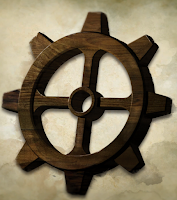This post is a reissue of the XP initially awarded here. In discussions with the group since we played earlier this week, there are two issues I’d like to correct in favor of the party.
The first is that XP was not originally awarded for the magical longsword and military pick. These were intentionally omitted because they were discovered under circumstances where “there was no real danger associated with obtaining them.” In truth, that shouldn’t really matter: the party still plundered them and we’ve also had at least once previous instance where XP was awarded for items acquired in non-combat situations.
The second is that the XP total was divided evenly among all party members prior to halving the henchman’s share, instead of dividing the total into shares that would consume the entire allotment. This, too, was intentional, and I’ve actually been divvying XP this way for some time. Philosophically, it equates to a henchman requiring two of the group’s points to earn a single XP; the math is also much simpler.
After further research and deliberation, I’ve decided to revert to the approach where the entire XP allotment is used, with no “XP waste.” Either method can be argued as canon, but I’d rather err on the side of the party. Further, I don’t feel that the “divide first, then halve” method scales fairly with multiple henchmen. For example, in a situation where 6,000 XP is earned by a party of four PCs and two henchmen, the “no waste” method awards 1,200 XP to each PC and 600 XP to each henchman (1,200 + 1,200 + 1,200 + 1,200 + 600 + 600 = 6,000), however the “divide first” method gives only 1,000 XP to each PC and 500 XP to each henchman, with an effective “loss” of 1,000 XP (1,000 + 1,000 + 1,000 + 1,000 + 500 + 500 = 5,000) - an entire share!
This definitely feels wrong and, as we now have more than one henchman in the party, I can’t rightly defend the use of the “divide first” method going forward.
In light of these changes, the total XP earned for the last two sessions is 11,500 (10,000 for the behir and 1,500 for treasure plundered). This is divided into sevenths, with two parts going to each of Zargon, Audric, and Zeb, and one part going to Lom. Individual allotments:
The first is that XP was not originally awarded for the magical longsword and military pick. These were intentionally omitted because they were discovered under circumstances where “there was no real danger associated with obtaining them.” In truth, that shouldn’t really matter: the party still plundered them and we’ve also had at least once previous instance where XP was awarded for items acquired in non-combat situations.
The second is that the XP total was divided evenly among all party members prior to halving the henchman’s share, instead of dividing the total into shares that would consume the entire allotment. This, too, was intentional, and I’ve actually been divvying XP this way for some time. Philosophically, it equates to a henchman requiring two of the group’s points to earn a single XP; the math is also much simpler.
After further research and deliberation, I’ve decided to revert to the approach where the entire XP allotment is used, with no “XP waste.” Either method can be argued as canon, but I’d rather err on the side of the party. Further, I don’t feel that the “divide first, then halve” method scales fairly with multiple henchmen. For example, in a situation where 6,000 XP is earned by a party of four PCs and two henchmen, the “no waste” method awards 1,200 XP to each PC and 600 XP to each henchman (1,200 + 1,200 + 1,200 + 1,200 + 600 + 600 = 6,000), however the “divide first” method gives only 1,000 XP to each PC and 500 XP to each henchman, with an effective “loss” of 1,000 XP (1,000 + 1,000 + 1,000 + 1,000 + 500 + 500 = 5,000) - an entire share!
This definitely feels wrong and, as we now have more than one henchman in the party, I can’t rightly defend the use of the “divide first” method going forward.
In light of these changes, the total XP earned for the last two sessions is 11,500 (10,000 for the behir and 1,500 for treasure plundered). This is divided into sevenths, with two parts going to each of Zargon, Audric, and Zeb, and one part going to Lom. Individual allotments:
- Audric - 3,286
- Zeb - 3,614
- Zargon - 3,286
- Lom (h) - 1,642
- Audric - 19,689
- Zeb - 3,000/40,162
- Zargon - 14,789
- Selben (h) - 11,101
- Lom (h) - 2,892
In addition to Audric and Lom, Zeb also advances, becoming the first PC in the campaign to reach level 6! Hopefully this is agreeable to everyone. While I'm still considering options to improve the way the XP is allocated in our game, I'll plan to continue using this approach until any change is made official.





